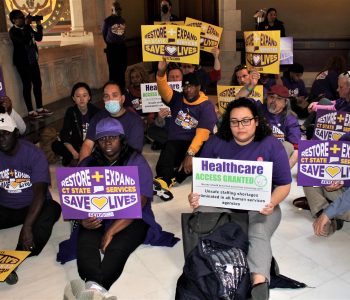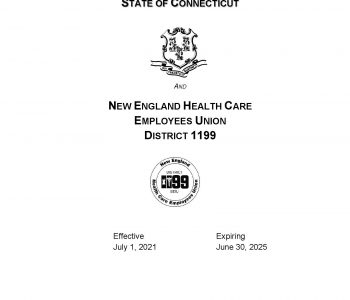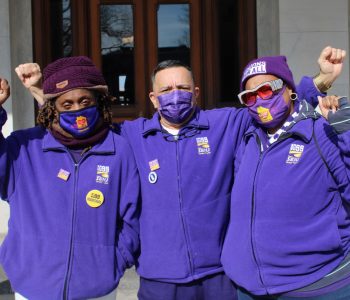When the first Connecticut prison inmate tested positive for COVID-19 at the end of March, officials at the Department of Correction acted fast. The 32-year-old man had been isolated from the rest of the incarcerated population at Corrigan-Radgowski Correctional Center as soon as he started showing symptoms. Once he tested positive, authorities placed him in a special room designed to prevent contamination from spreading through the prison.
To transfer the sick man to the negative pressure room, however, he had to be escorted from his cell through a shared common area, up an elevator and through the medical unit, where two inmates were being treated for cancer. The problem, said Casey Verito, a nurse at the penitentiary, is obvious — that transfer risked contaminating the entire facility.
“They weren’t supposed to do that, per our medical protocols,” said Verito.
In the more than two weeks since the first inmate tested positive for the coronavirus, medical staff say incarcerated people have been sporadically shuffled around the prison, seemingly contradicting policies to limit movement within the facility.
“The initial plan they presented about just locking it down, keeping everybody in place to minimize the spread, sounded pretty practical,” said Steven Swan, an LPN at the prison. “That changed quickly. Lots of movement happened.”
Neither the correctional facility’s medical leadership nor frontline staff were consulted as inmates were moved around the prison, say members of SEIU Healthcare 1199NE, Connecticut’s largest healthcare workers’ union. Now, roughly 20 of the 32 union health care workers are out sick with confirmed or suspected cases of COVID-19, and 57 inmates at the Uncasville prison had contracted the virus as of Thursday.
“It made no sense,” said Verito, who has since recovered from COVID-19 and is back at work. “It was blatantly going against what medical advice was.”
COVID-19 has spread quickly throughout Connecticut’s prisons and jails. As of April 17, 246 incarcerated people had been infected with a virus, more than 30 times the number of inmates who had the coronavirus on April 2.
As the outbreak has worsened, advocates and family members with loved ones behind bars have increased their demand the state release incarcerated people to spare them from contracting the virus in jail or prison.
“I’ve got folks protesting in front of my residence here every few days, ‘Let ’em out, let ’em out,’ and I appreciate more than anybody that all these congested environments — be it the correctional facilities, be it the homeless shelters, be it the nursing homes — are just Petri dishes,” Gov. Ned Lamont said during a CT Mirror “Zoom and Brews” video chat on Wednesday. “That said, I think we’ve done a reasonably good job. Because the population is at the lowest level in a generation or so, we do have a lot of extra capacity there.”
There were 1,022 fewer people in state jails and prisons on April 17 than March 1, primarily because there are fewer people entering the criminal justice system. Lamont suggested the new space could help corrections medical staff care for those who get sick, and that officials could “re-circulate the air” to mitigate the spread of the virus.
“They’ll be in better position to heal or stay safe there than if they get out,” Lamont said. “I think we’re doing everything we can to decongest all those areas.”
Health care workers say Corrigan-Radgowski, as the first correctional facility where an incarcerated person contracted the virus, is a case study for how the Department of Correction mishandled the early stages of an outbreak. They also say it’s a warning.
“The outbreak of coronavirus witnessed at Corrigan-Radgowski should have been prevented,” said Rob Baril, president of SEIU 1199NE. “Now, more than half of the 32 healthcare workers who are regularly assigned to this correction institution are quarantined with COVID-19 symptoms. The Department of Correction must turn this around 180 degrees or we’ll see the same situation unfold at other facilities. And we’re already starting to see that unfold.”
A series of missteps
The problems at Corrigan-Radgowski began before any inmates tested positive for the virus. According to emails sent by the prison’s nursing supervisor and a head nurse to the DOC management earlier this month, health workers were following the department’s Pandemic Influenza Response Plan in mid-March. All appeared relatively well. Negative pressure rooms were utilized before quarantining the sick, and new intakes were held in the prison’s A pod if they were symptomatic or answered “yes” to a COVID questionnaire.
Nursing staff performed assessments of inmates sent to Corrigan from Radgowski — they are separate buildings — without wearing a mask. They were told to rule out the flu, “even though we were all aware of the pandemic that was occurring,” Kristen Fernandez, the correctional facility’s head nurse, wrote in a letter addressed to higher-ups at the Department of Correction.
“I was taking care of inmates for weeks without a mask,” said Verito.
On March 25, Corrigan-Radgowski’s first employee tested positive for the virus. That employee had last entered the correctional facility four days earlier. Medical staff say the prison should have been locked down at that point, given that the employee worked at Radgowski, where inmates sleep in dormitory-style housing, a living condition that makes it difficult, if not impossible, to practice social distancing.
On March 30, the DOC announced an inmate at Corrigan-Radgowski had tested positive for COVID-19. The plan changed in early April. Seemingly healthy inmates were transferred out of H pod to the gym, and all those who were quarantined throughout the prison were moved to H pod.
“This became our new quarantine unit. Please understand that medical was NEVER part of these meeting or included in making any of these decisions,” Kara Phillips, nursing supervisor, said in a message sent to DOC Deputy Commissioner Cheryl Cepelak on April 6.
H pod is the furthest from the facility’s medical section, making it an inopportune space to house the infected. And moving all the seemingly healthy into a confined space may have exacerbated the virus’ spread, said Swan.
“We don’t know who had already had it and was asymptomatic at that point,” he said.
It wouldn’t have been possible to house all of the sick inmates in the negative pressure rooms, Swan acknowledged, because there are only four of them. “There’s not enough to handle something like this.”
Incarcerated people have been frequently shuffled since the first inmate tested positive.
“Some inmates literally have been moved four times since being on quarantine,” Phillips wrote. “The facility is contaminated.”
A DOC spokesperson said authorities began transferring all incarcerated people with COVID-19 to Northern Correctional Institution effective April 7. As of Thursday, 22 inmates have been medically cleared and sent back to Corrigan-Radgowski from Northern.
Medical staff say they repeatedly sent their concerns up the chain of command: stop movement within the facility, give staff adequate personal protective equipment and better support through issuing a unified, clear, rigid plan.
That didn’t happen. Verito said there was “no direction at all… If they just listened, I feel like a lot of people wouldn’t have gotten sick.”
“This is a medical pandemic, why wouldn’t we have medical professionals there to weigh in on concerns, plans, and what is best for the facility?” Fernandez wrote in her note to the DOC. “I’m so confused. I could continue to go on with this, but I feel as if deaf ears is all our concerns ever fall on.”
Karen Martucci, the DOC’s spokeswoman, said in an email that the department has “gone to great lengths to remain transparent during this health pandemic,” and has created a webpage with links to inter-agency memos and data that is updated daily.
She also said the agency is protecting the staff and incarcerated population by collaborating with state leadership while they receive input from custody and treatment staff, as well as health care professionals and labor unions.
Martucci declined to respond to specific questions about how the outbreak at Corrigan-Radgowski was handled, however.
“Facility specific pandemic plans, however, are part of our confidential emergency procedures,” Martucci said. “In addition to this unprecedented pandemic, the Department must also remain ever vigilant in its efforts to maintain the safety and security of its facilities.”
Concerns over personal protective equipment
The first inmate at Corrigan-Radgowski to test positive for COVID-19 weaponized the virus, spitting at staff through the bottom crack of the negative pressure room.
“He was probably scared to death,” Verito said. “We didn’t have any answers for him.”
Tensions are high at the Uncasville prison, staff say. Those who are incarcerated are frustrated and scared, potentially making an already tense situation worse.
“When you’re telling somebody they’re only allowed out [of their cell] for a shorter period of time, they’re not happy,” Steven Wales, a correction officer at Corrigan and a member of the executive board on AFSCME Local 1565i, said of quarantine plans. “These guys are pissed off.”
Vulnerability to bodily fluids and movement of incarcerated people within the facility underscore the need for personal protective equipment, staff say.
“Medical staff know they might be exposed to this kind of thing, but they expected to be given the proper equipment to deal with it,” said Swan.
In a memo sent to all DOC staff on April 14, Commissioner Rollin Cook assured employees the department was working to ensure they were protected from the virus.
“To be totally candid, I am frustrated by the fact that our Agency does not have the full inventory of PPEs that it should,” Cook wrote. “Even more disheartening is the thought that some have suggested that I do not care whether or not staff have the protective equipment they need. As someone who is essentially a correctional officer at heart, nothing could be further from the truth.”
As of April 14, the department had 6,976 N-95 masks,1,000 of which were for the COVID unit at Northern Correctional Institution. The department also received a shipment of materials on April 3 that included 7,000 face shields, 100,000 gloves and 6,750 isolation gowns. Cook has also authorized employees to wear their own face masks that they can bring to work from their homes, and said all DOC employees were given surgical masks for use this week.
“Despite the difficulties in obtaining PPEs, I want you to know I will continue to fight to get the equipment our staff needs and deserves,” Cook said. “I have a moral and ethical obligation to protect our employees and the offender population under our care, and that is exactly what I intend to do.”
Altogether, 30 staff at Corrigan-Radgowski had tested positive for COVID-19, according to an email from a DOC spokesperson sent on Thursday. Three employees have since returned to work.
Swan said the sick people who remain at the facility seem to all be confined to the H pod. The virus seems contained for now. But health care staff could still use guidance from the department.
“We don’t know the procedure of the day. It seems to change every day. When you don’t know what to do, it’s hard to do it,” Swan said. “Clear communication on a regular basis would help things exponentially.”
Article from The CT Mirror by KELAN LYONS
Shifting plans and a COVID-19 outbreak at a Connecticut prison









